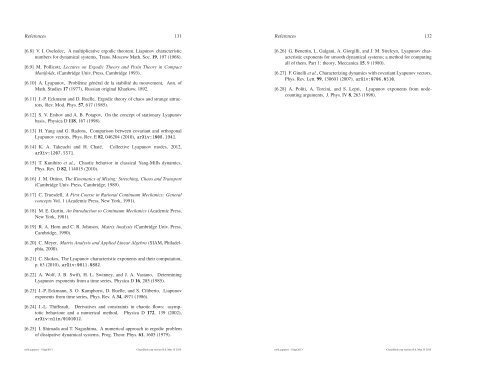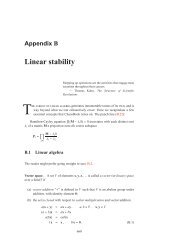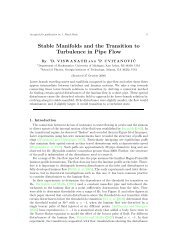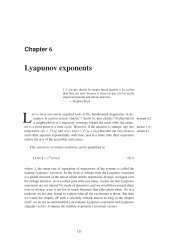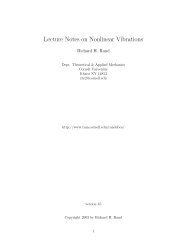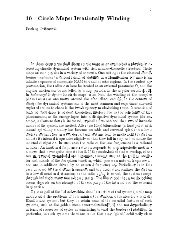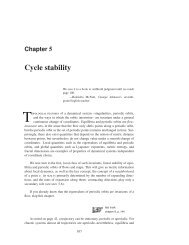Create successful ePaper yourself
Turn your PDF publications into a flip-book with our unique Google optimized e-Paper software.
References 131References 132[6.8] V. I. Oseledec, A multiplicative ergodic theorem. Liapunov characteristicnumbers for dynamical systems, Trans. Moscow Math. Soc. 19, 197 (1968).[6.9] M. Pollicott, Lectures on Ergodic Theory and Pesin Theory in CompactManifolds, (Cambridge Univ. Press, Cambridge 1993).[6.10] A. <strong>Lyapunov</strong>, Problème général de la stabilité du mouvement, Ann. ofMath. Studies 17 (1977), Russian original Kharkow, 1892.[6.11] J.-P. Eckmann and D. Ruelle, Ergodic theory of chaos and strange attractors,Rev. Mod. Phys. 57, 617 (1985).[6.26] G. Benettin, L. Galgani, A. Gi<strong>org</strong>illi, and J. M. Strelcyn, <strong>Lyapunov</strong> characteristic<strong>exponents</strong> for smooth dynamical systems; a method for computingall of them. Part 1: theory, Meccanica 15, 9 (1980).[6.27] F. Ginelli et al., Characterizing dynamics with covariant <strong>Lyapunov</strong> vectors,Phys. Rev. Lett. 99, 130601 (2007),arXiv:0706.0510.[6.28] A. Politi, A. Torcini, and S. Lepri, <strong>Lyapunov</strong> <strong>exponents</strong> from nodecountingarguments, J. Phys. IV 8, 263 (1998).[6.12] S. V. Ershov and A. B. Potapov, On the concept of stationary <strong>Lyapunov</strong>basis, Physica D 118, 167 (1998).[6.13] H. Yang and G. Radons, Comparison between covariant and orthogonal<strong>Lyapunov</strong> vectors, Phys. Rev. E 82, 046204 (2010),arXiv:1008.1941.[6.14] K. A. Takeuchi and H. Chaté, Collective <strong>Lyapunov</strong> modes, 2012,arXiv:1207.5571.[6.15] T. Kunihiro et al., Chaotic behavior in classical Yang-Mills dynamics,Phys. Rev. D 82, 114015 (2010).[6.16] J. M. Ottino, The Kinematics of Mixing: Stretching, Chaos and Transport(Cambridge Univ. Press, Cambridge, 1989).[6.17] C. Truesdell, A First Course in Rational Continuum Mechanics: Generalconcepts Vol. 1 (Academic Press, New York, 1991).[6.18] M. E. Gurtin, An Introduction to Continuum Mechanics (Academic Press,New York, 1981).[6.19] R. A. Horn and C. R. Johnson, Matrix Analysis (Cambridge Univ. Press,Cambridge, 1990).[6.20] C. Meyer, Matrix Analysis and Applied Linear Algebra (SIAM, Philadelphia,2000).[6.21] C. Skokos, The <strong>Lyapunov</strong> characteristic <strong>exponents</strong> and their computation,p. 63 (2010),arXiv:0811.0882.[6.22] A. Wolf, J. B. Swift, H. L. Swinney, and J. A. Vastano, Determining<strong>Lyapunov</strong> <strong>exponents</strong> from a time series, Physica D 16, 285 (1985).[6.23] J.-P. Eckmann, S. O. Kamphorst, D. Ruelle, and S. Ciliberto, Liapunov<strong>exponents</strong> from time series, Phys. Rev. A 34, 4971 (1986).[6.24] J.-L. Thiffeault, Derivatives and constraints in chaotic flows: asymptoticbehaviour and a numerical method, Physica D 172, 139 (2002),arXiv:nlin/0101012.[6.25] I. Shimada and T. Nagashima, A numerical approach to ergodic problemof dissipative dynamical systems, Prog. Theor. Phys. 61, 1605 (1979).refs<strong>Lyapunov</strong> - 18apr2013 <strong>ChaosBook</strong>.<strong>org</strong> version15.6, Mar 15 2015refs<strong>Lyapunov</strong> - 18apr2013 <strong>ChaosBook</strong>.<strong>org</strong> version15.6, Mar 15 2015


